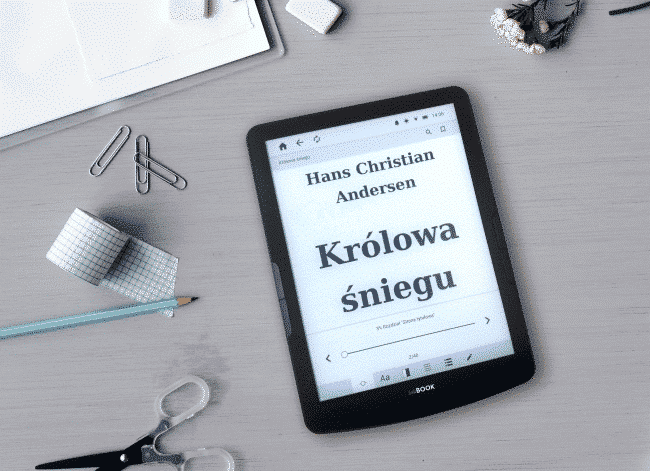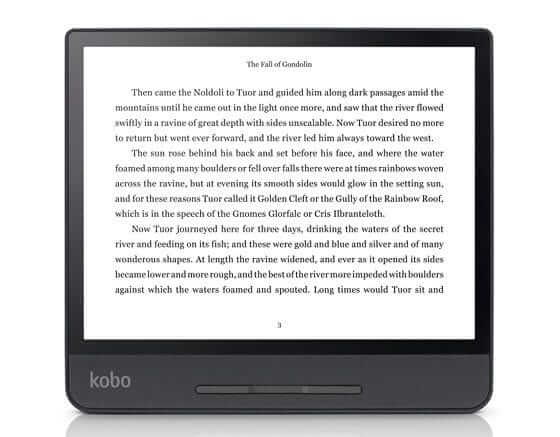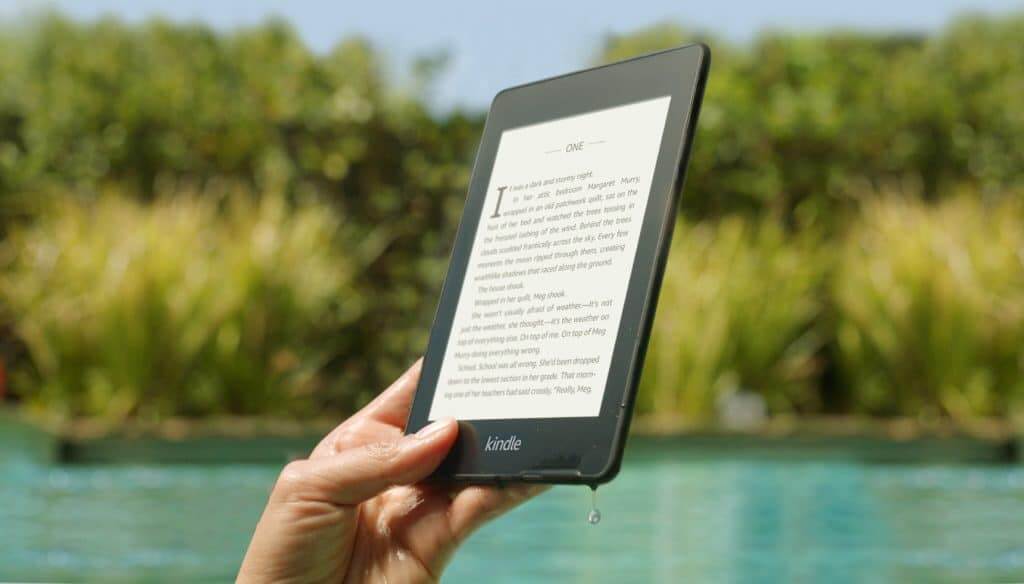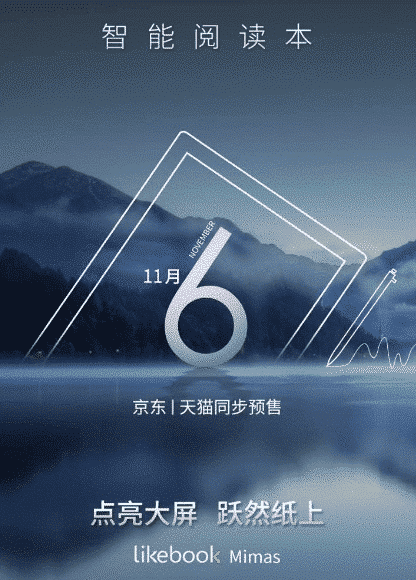Over the course of the past few years e-readers have been enjoying a resurgence in popularity. Companies are taking more design risks and small startups are enjoy robust sales for very niche devices. Some of the most notable new e-readers that have been enjoying massive success are the Remarkable, Sony DPT-RP1, Onyx Boox Note and Kindle Oasis 2. In 2018 there is going to be a slew of new digital readers that will be released in all shapes and sizes, here is everything you need to know.
The eOnebook was made in Japan by Progress Technologies and it features two 7.2 inch screens that open and close like a real book. The company had a very successful Kickstarter campaign and it will be released in Japan this summer and worldwide later this year.
Each eOnebook will come with an entire manga library, the first edition has the entire series of Fist of the North Star. Progress told me that they are working on five other manga series and talking with some major publishers to get more content. Each e-reader is preloaded with a single manga series and you cannot sideload any other content.
The Sony Digital Paper DPT-Cp1 is a new 10.3 inch e-reader and digital note taking device and it is going to be available to purchase on the Sony Japan website in June and the US a few months later. The DPT-Cp1 features an E-Ink Carta display with a resolution of 1872×1404 with 227 PPI. It has a capacitive layer for touchscreen interactions and also one for the stylus to take notes and write on PDF files and it supports A5 documents.
Underneath the hood is a Marvell (R) IAP 140 64-bit Quad-core IoT Applications Processor, 16GB of internal storage, WIFI and Bluetooth 4.2. The dimensions are 174.2 × 243.5 × 5.9 mm and it weighs approximately 240 g.
There is no word yet on US pricing, but it should be at least $100 cheaper than the DPT-RP1, which is a 13.3 inch e-reader and retails for around $699 USD.
The InkBook Infinity is the most compelling device that Artatech has ever developed. They are putting in a ton of effort into the industrial design process to make it stand out from their immediate competition.
The Infinity features a 10.3 inch E-Ink Carta display with a resolution of 1872×1404 and 267 PPI. It will have a color temperature front-lite screen with around 19 LED lights. This will allow you to read in the dark with a brilliant clarity or you can mute the white light into various degrees of orange. They are also developing a dedicated stylus pen that will turn the Infinity into a dedicated note taking device.
Underneath the hood will be a 1GHZ i.MX6SL with REGAL, 1GB of RAM, 8GB of internal storage and SD support for an additional 32GB. This will be the second e-reader on the market with USB-C support and it will have a 3000 mAh battery, which will give you about a week of non-stop use and running apps all the time.
This e-reader will likely be released this summer and the pricing is unknown.
Inkbook Explore
The Inkbook Explorer features a 7.8 inch E Ink Carta display with a resolution 1872 X 1404 with 300 PPI. It has a front light and adjustable color temperature screen so you can read in the dark and help mute the bright lights.
Underneath the hood is a i.MX6SL (with built-in E Ink controller), 512MB of RAM, 8GB of internal storage and a Microsd slot that is capable of handling a 32GB card. This is one of the few e-readers on the market that has USB-C, Onyx is the other brand. The Explorer is powered by a 3000 mAh battery, so you should get a few weeks of usage.
Inkbook has kept the Bluetooth availability so users can still install their favorite audiobook apps and listen at any time. Speaking of apps, this device is running Android 4.4.4, but doesn’t have any app store to download additional content. You will most likely have to download the Good e-Reader App Store for E Inkin order to download apps. It is retailing for $189 USD and you can order it from the Inkbook website, until its available on Amazon.
Inkbook Lomus
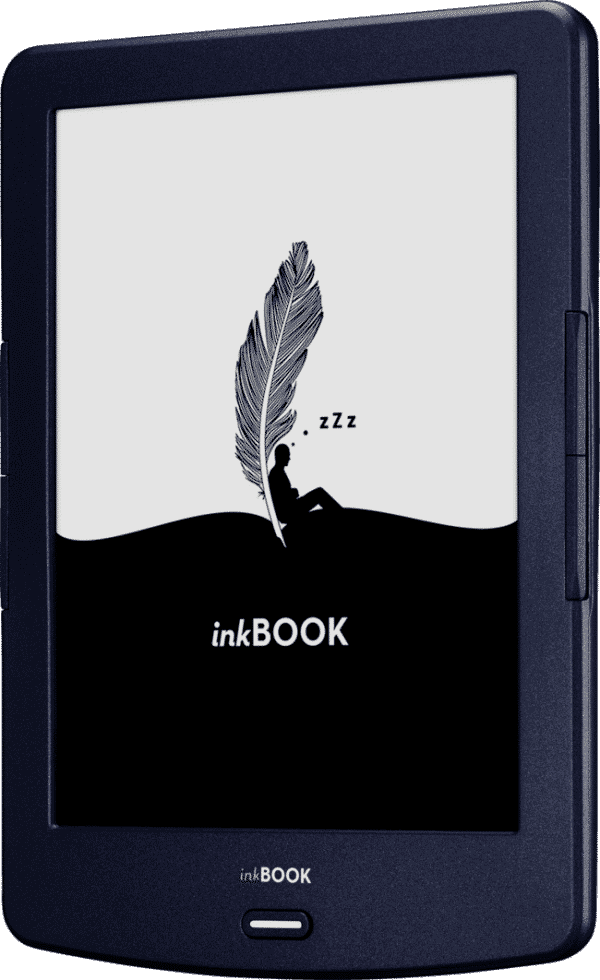
The Kobo Forma has a giant 8 inch capacitive touchscreen display with a resolution of 1440 × 1920 and 300 PPI. Many e-readers are using Carta HD or Mobius for the screens, but Kobo is using both. Now you might be wondering, how is this e-reader using two different screen technologies at the same time? The spec sheet for the Forma mentions that it uses both Mobius and Carta HD. Like most display technologies, E Ink displays use an active matrix thin film transistor (TFT) backplane. The TFT backplane is an array of transistors that are typically deposited on a piece of glass. These transistors control each pixel on the display. The layer on top of the TFT backplane determines the actual display type (e.g. E Ink, LCD, OLED, etc.). In the case of E Ink, this layer contains the actual ink particles that creates the image. The Carta technology is the latest version of this layer and determines the optical properties, such as contrast ratio. The Mobius technology replaces the glass TFT backplane with a flexible plastic TFT backplane. This plastic backplane is thinner, lighter and stronger than glass backplanes. This in turn enables Kobo Forma’s lightweight and ergonomic design. Kobo claims that by using Mobius the e-reader is 15% lighter than the Kobo Aura One and weighs 197g.
Underneath the hood is a Freescale/NXP IMX6 Solo Lite 1 GHZ processor. It has 512MB of RAM and has two different storage options, 8GB and 32GB. The 32GB version initially will only be available in Japan, but it should have wider availability in more markets next year. Choosing the right storage option is important, because the Forma does not have expandable storage via an SD card. It also has a power button and USB port for charging.
Kobo has developed a new e-reader called the Clara HD and the product should be released sometime next month. This device just hit the FCC and the official specs are embargoed, which is what Kobo normally does when they are about to release something new.
Clara is an internal codename and the final product will have another name. It is unknown what this device actually is. I believe that it is the Mini 2, which will retail for under $60 and will assist Kobo in selling a lot of e-readers in Walmart stores in the United States.
Onyx Boox Note S

Onyx Boox Note Plus
The Onyx Boox Note Plus features a 10.3 inch E-ink Mobius and Carta display and a resolution of 1872×1404 and 227 PPI. It has a glass based layer that is scratch resistant and also a electromagnetic handwriting (WACOM electromagnetic) layer for stylus support.
One of the big advantages of a glass based display is that the screen is completely flush with the bezel. It ensures that you can draw from the very edge of the screen to the other and can press really hard with the stylus and not scratch the screen. I am a big fan of glass screens because it is easier to swipe and gesture when using Android apps or turning the pages of an ebook.
Some people think that glass screens are brittle than flexible e-paper. I have been covering e-readers for a decade and only a handful of people have ever actually managed to crack the screen and this occurred because they dropped it on concrete or are habitually clumsy. If you feel that you want to take better care of the Note Plus, I suggest just buying a carrying case.
Underneath the hood is a 1.6GHZ quad core processor, 2GB of RAM, 32GB of storage,dual speakers, mic, Bluetooth 4.0, USB C and WIFI. Onyx was the first e-reader company to employ a quad processor and it dramatically increases the performance of navitating around the device, surfing the internet, turning the pages of a book or using Android apps. This thing is a beast and can handle most tasks like a champ.
Onyx Boox is going to be releasing the MAX 2 PRO e-reader on November 20th 2018. This device is going only going to read ebooks, but also function as a secondary monitor for your computer and a sheet music reader.
The Onyx Boox MAX 2 PRO features a 13.3 inch E Ink Carta and Mobius screen. This is the same technology that Kobo employed in the Forma. Mobius makes the device lighter and function better during drop tests. The resolution is 2220×1650 and has a PPI of 207. It has a WACOM screen that is capacitive, so you will be able to take notes and draw with the accompanied stylus or interact with the screen via five point multitouch.
Onyx Boox Note Lite
The Onyx Boox Note Lite is a new 10.3 inch e-reader that forgoes the WACOM digitizer layer and only has a capacitive touchscreen display. The Note Lite is geared towards people who want a large screen e-reader to read comics, books, manga, magazines, newspapers and PDF documents.
The Note Lite features a 10.3 inch flexible capacitive touchscreen display with E Ink Carta. The resolution is 1872×1404 and 227 PPI. Underneath the hood is a 1.6GHZ quad core processor, 2GB of RAM, dual speakers, mic, Bluetooth, 32GB of storage and USB C. Sadly it does not have a front-lit display, so you will not be able to read in the dark.
This device is running Android 6.0 and it has Google Play. Onyx has developed their own app store which will also be pre-loaded and although it only has 26 apps available on it, all of the apps have been optimized for the Onyx Lite. For example, the Kindle app has been customized to have no animated page turns, so reading your books is lightning quick.
Amazon
Amazon will be releasing the Kindle Paperwhite 4 later this year and it will feature an all new comfortlight system. This technology will mute the vibrantly white screen in low light conditions make it easier to read. The Paperwhite will employ 17 LED lights, 10 white and 7 others. It will be announced sometime in October or November and be released soon thereafter.
LAB126 the secretive research and development facility has designed every single product Amazon has ever released and last year they created a bunch of engineering prototypes of the Paperwhite 4 to try and nail down the design. Amazon was not happy with the current direction of comfortlight screens, since the e-readers issued by Barnes and Noble, Kobo and Tolino were predominantly orange. LAB126 was mandated to come up with a new lighting system to mute the orange colors to eliminate white light, but still create a solid reading experience. It looks like early this year they solved the problem and “mass production is underway,” said sources in the upstream supply chain.
One of the big ventures of 2017 was Amazon incorporating their Audible audiobook unit into the second generation Oasis. A few months later they issued a series of firmware updates updates to the Kindle Basic and first generation Oasis. The Paperwhite 3 was the odd man out, but this will change with the advent of the Paperwhite 4 and users will be able to plug in a pair of wireless headphones or speaker and listen to their audiobooks.
It is rumored that the new Paperwhite will employ the IMX.7 dual core processor, but this has not been confirmed.
The new Paperwhite 4 will be apart of the 3 SKU strategy. Amazon will only be marketing the lowend Basic, Paperwhite and the Oasis. The Voyage is going to be phased out and most models are out of stock in Canada the US store.
There are a few unconfirmed rumors. One will be that the new Paperwhite will have two different variants of internal storage; 8GB and 32GBS. There will be a white and black variant for more color options. The other rumor, which is a bit of a stretch is that it will employ the IMX.7 dual core processor.
Amazon Kindle Paperwhite 4
The Paperwhite 4 features a 6 inch E Ink Carta HD capacitive touchscreen display with a resolution of 1430×1080 and 300 PPI. PC Magazine says that “Amazon is using a plastic-backed 300ppi E Ink display, but it isn’t E Ink Mobius; it’s the company’s own design.” The screen is completely flush with the bezel and this is done because it is the first Paperwhite that is waterproof with IPX8 certification. This means you can read in the bathtub or at the beach. It is also immune to spills such as coffee or tea.
This device does have a front-lit display with five LED lights, whereas the Kindle Paperwhite 3 only had four LED lights. This lighting system primarily is used to read in the dark and Amazon claims that the additional LED will provide more uniform light across the screen. I have heard that Amazon is incorporating these LED lights on the top of the screen, whereas all prior models had them on the bottom.
I find it interesting that Amazon decided against using a color temperature lighting system. They have been experimenting with both red and blue LED lights to help warm the screen up, but it looks like they never found the proper balance and decided against employing it on the Paperwhite 4.
Underneath the hood is a Freescale 6SLL Cortex-A9 @800M/1GHz processor and 512MB LPDDR3 of RAM. There are two different storage models, depending on your needs. The first is 8GB which is twice the amount that the Kindle Paperwhite 3 employed and a 32GB model, which is ideal for people who have large collections of manga or PDF files.
The all-new Kindle Paperwhite is is the thinnest and lightest Kindle Paperwhite yet, measuring 8.18mm thick and weighing 182g—less than half the weight of many paperback books—so extended reading sessions are even more comfortable. Speaking of reading, this device supports Kindle Format 8 (AZW3), Kindle (AZW), TXT, PDF, unprotected MOBI, PRC natively; HTML DOC, DOCX, JPEG, GIF, PNG, PMP through conversion; Audible audio format (AAX).
The Pocketbook Touch Lux 4 features a six inch E Ink Carta display with a resolution of 1024×758 and uses a capacitive touchscreen. It has a new front-lit display, packing in more LED lights than previous models due to the color temperature system. Pocketbook told me that the Lux 4 features the same design as the InkPad 3.
Underneath the hood is a Freescale/NXP 1GHZ single core processor, 512MB of RAM and 8GB of internal storage. There is a MICROSD support for an additional 32GB of storage. If you max out the SD, you should have room for over 3,000 ebooks.
PocketBook Touch Lux 4 supports 17 book formats and 4 graphic formats, such as JPEG, BMP, PNG, TIFF. The built-in Wifi together with the PocketBook Cloud, Dropbox PocketBook and Send-to-PocketBook services allow easy delivery of e-content onto the e-reader without connecting it to a PC. The preinstalled Abbyy Lingvo dictionaries offer 24 language combinations for reading books in foreign languages.
The new PocketBook Touch Lux 4 is available in obsidian black, matte silver and emerald colours. It weighs 155 g and dimensions are 161.3 × 108 × 8 mm. It has a 1500 mAh battery, so it should last two to three weeks of constant use.
This e-reader will be retail for 119 EUR.
Pocketbook Basic Lux 2
The Pocketbook Basic Lux 2 does not have a capacitive touchscreen display, everything is controlled via the D-Pad. This device is six inches and uses a E Ink Carta screen with a resolution of 1024×758. You can read at night via the front-lit display, but it has less LED’s than the Lux 4.
Underneath the hood is a Freescale 1GHZ processor, 512MB of RAM, 8GB of internal storage and a SD card capable of an additional 32GB of storage. The built-in Wifi together with the PocketBook Cloud, Dropbox PocketBook and Send-to-PocketBook services give convenient opportunities to deliver any e-content to the device without having connection to a PC. The e-reader supports 17 book and 4 graphic formats, such as JPEG, BMP, PNG, TIFF, without conversion. The preinstalled dictionaries offer two language combinations to read books in foreign languages.
I really dig the design of the Basic Lux 2, it is small and has a single home button, it looks like a smartphone and there are two manual page turn buttons beside it. What looks like the home button is actually a D-Pad, this is used to navigate around the UI. The e-reader is available in obsidian black and matte silver colours. It weighs 155G and dimensions are 161.3 × 108 × 8 mm.
The Basic Lux 2 should be available in a week or two and will retail for 85 EUR.
Pocketbook Touch HD 3
Pocketbook has just announced the Touch HD 3 at the Frankfurt Book Fair and the company is betting that their premium features will be a big draw. The device has a color temperature system called Smartlight that will help mute the bright white LED’s of the front-lit display and it is also waterproof with an IPX7 rating, so you can read while in the bath or at the beach. It also has audio support via Bluetooth, so you can listen to music or audiobooks.
The Pocketbook Touch HD 3 features 6 inch E Ink Carta HD screen with a resolution of 1440X1080 and 300 DPI. It has a front-lit display to read in the dark and also a color temperature system that warms the screen up. It also has an IPX7 rating, so it will survive being completely submerged for around 30 minutes and will also be immune to dumping liquids on it. The screen is not completely flush with the bezel, instead it has a very small dip.
Underneath the hood is Dual Core 2.1 GHZ dual core processor, 512MB of RAM and 16GB of internal storage, but does not have an SD card. One of the big selling points behind this device is the audio support. Integrated audio features are available via a micro USB audio adapter and Bluetooth wireless connection. The PocketBook Touch HD 3 supports both mp3 and m4b audio formats, providing a convenient opportunity to listen to and bookmark your audio books. The Text-to-Speech function converts text into voice and allows the e-reader to read aloud any text file from the device’s supported formats.
Boyue Likebook Mars
The Likebook Mars features a 7.8 inch E Ink Carta touchscreen display with a resolution of 1782×1448 and 300 PPI. The screen has a small dip where the screen meets the bezel, since it is not using a glass based display, which would increase the price.
The Mars has a front-lit display with 17 LED lights, the vast majority of them are white and the rest are orange to give a candlelight effect. Many e-readers that have a color temperature system have two different sliders, one for each. The Boyue has one slider that controls the luminosity of the white LED lights and if you hit the moon button you can control the brightness of the candlelight effect. I like this condensed approach, it minimizes the amount of space the lighting control system takes up.
Underneath the hood is a 8 core 1.5 GHZ processor with 2GB of RAM and 16GB of internal storage. This is the first e-reader ever made with an octa-core processor. It also has support for Bluetooth, WIFi, 3.5mm headphone jack, but doesn’t have built in in speakers.
The Mars has a SD card, something many companies seem to be forgoing. Kobo no longer includes an SD card in any of their e-readers and ditto with the Kindle. Even Onyx Boox has decided to not include expandable storage to any of their higher priced Note e-readers. Mars supports an additional 128GB.
Boyue is going to be releasing a larger version of the Likebook Mars on November 6th in China and it should be available in North America soon thereafter. The Boyue Likebook Mimas has been teased on the companies official Twitter account and also on a Chinese forum. There is no word on how much it will cost.
The Boyue Likebook Mimas features a 10.3 inch capacitive touchscreen display with a resolution of 1872×1404. You will be able to read in the dark at night via the front-lit display and it also has a color temperature system. Instead of being black like the 7.8 Mars, the Mimas will have a white chassis.
Underneath the hood is a octa-core 1.5ghz processor, 2GB of RAM and 16GB of internal storage. It will have an SD card capable of 128GB of expandable storage. It will be powered by a 4700 mAh battery and have USB-C for charging and transferring of data. The Mimas also has audio functionality via the two speakers on the back, a 3.5mm headphone jack and Bluetooth support for wireless headphones. You will be able to use Skype or Whatsapp or other chat options that rely on a microphone, since this model has one. But it does not have a camera.
Tolino Shine 3
The Shine 3 features a six inch capacitive touchscreen display with E Ink Carta HD and a resolution of 1448×1072 pixels and 300 dpi. The frontlit display and color temperature system allow customers to read in the dark and help mute the bright white screen with varying degrees of orange, to provide candlelight effect. Tolino bills their lighting system as “Smart Light.”
Underneath the hood is a Freescale IMX6 Solo Lite 1GHZ processor, 512MB of RAM and 8GB of internal storage. There is an additional 25GB of storage space available via the Tolino Cloud. The battery is 1500 mAh and the dimensions are 110x156x8.35 mm and it weighs 166g.
This e-reader is available now for €119 from Thalia, Weltbild and Hugendubel or ordered online. Good e-Reader is trying to get a review copy and hopefully will conduct an extensive product review.
**This post will be updated as new products are announced or applications hit the FCC**
Michael Kozlowski is the editor-in-chief at Good e-Reader and has written about audiobooks and e-readers for the past fifteen years. Newspapers and websites such as the CBC, CNET, Engadget, Huffington Post and the New York Times have picked up his articles. He Lives in Vancouver, British Columbia, Canada.





